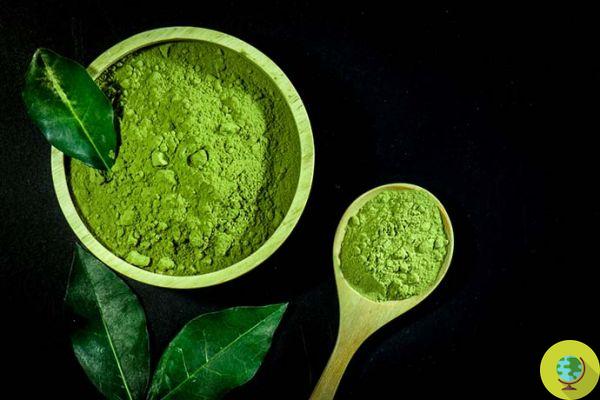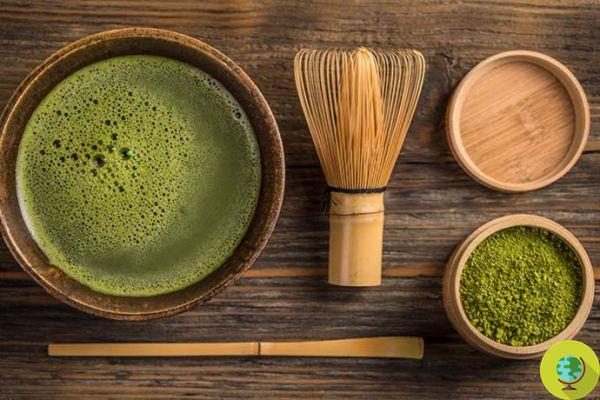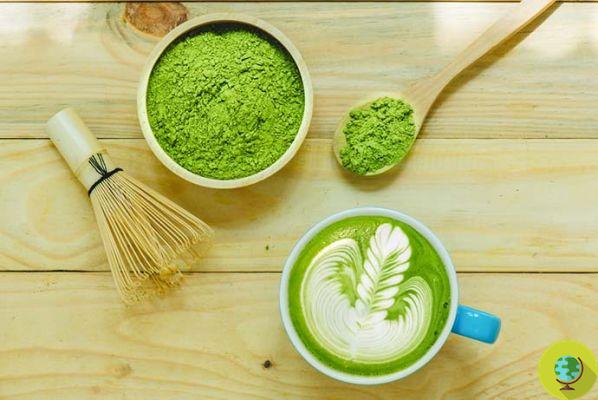Matcha tea, a Japanese drink that many appreciate for its taste and at the same time very rich in properties. But what happens to the body by taking one or more cups of it every day?
Don't store avocado like this: it's dangerousMatcha tea, a Japanese drink that many appreciate for its taste and at the same time very rich in property. But what happens to the body by taking one or more cups of it every day?
Matcha tea is obtained from the dried and then pulverized leaves of some varieties of green tea, particularly known as it is the one used in the tea ceremony in Japan, a real social but also spiritual ritual of ancient origin.
It is essentially a green tea with special characteristics, it is not by chance that it is also called the "king of green teas".
Index
Types of Matcha Tea
There are two types of matcha tea:
- Usucha: obtained from the leaves of young plants (less than 30 years old)
- Koicha: instead it is obtained from the leaves of tea plants older than 30 years
Both varieties are considered valuable and are used not only as drinks, but also to flavor sweets and enrich different recipes (see uses below).
Matcha tea and tea ceremony
The tea ceremony, of very ancient origins, was born in China initially with a therapeutic purpose, but then soon turned into something spiritual. In fact, it has become very dear to Japanese monks and to Zen philosophy.
It is also fundamental in Buddhism in which this ceremony is a moment of high spirituality that must lead to the achievement of inner peace. Matcha tea is used by monks during the hours of meditation to help them stay awake (it contains caffeine) and for this reason the drink is also known as the "elixir of Buddhist monks".
We should not be surprised that Matcha tea is used during the tea ceremony in different cultures, in fact it is a particularly valuable variety of tea.
Matcha tea, how it is produced
To make Matcha tea, we start with the cultivation of tea plants of the Gyokuro species which are covered with dark nets so that a very low amount of sunlight reaches the leaves. The plant thus produces chlorophyll and consequently is enriched with numerous properties.
Later, after having picked the leaves by hand during the month of May, they are steamed so that they avoid oxidation and keep their properties intact. They are then dried and finally ground in stone mills to obtain a powder that resembles face powder in consistency.

Matcha tea, nutritional values
Matcha tea is particularly rich in vitamins, minerals, antioxidants and other beneficial substances for our body. 1 gram of this infused tea guarantees:
- Dietary fiber 3.9 g
- 3.1 g protein
- Calcium 42 mg
- Iron 1.7 mg
- Potassium 270 mg
- Magnesium 23 mg
- Vitamin A Beta-Carotene 2.900 mcg
- Vitamin A Retinol Equivalent 240 mcg
- Vitamin B1 0.06 mg
- Vitamin B2 0.14 mg
- Vitamin C 6 mg
- Vitamin E 2.8 mg
Benefits and what happens to the body by drinking one cup a day
Matcha tea is so rich in properties that it can be considered a real superfood. It is probably the best among green teas and this is due to both the cultivation and production systems and the way it is prepared (see below).
Drinking one or more cups every day guarantees us:
- Antioxidants: It is the tea variety of green tea richest in polyphenols and other antioxidants. It is therefore very useful to keep free radicals responsible for cellular aging at bay.
- Better concentration: rich in vitamins, minerals and stimulants such as caffeine, this tea is excellent for stimulating concentration and learning. Perfect drink therefore to sip when studying or working.
- Increase Energy Rank: thanks to all its organoleptic characteristics, matcha tea is an excellent stimulant and helps to keep the energy level high throughout the day.
- Digestive: the substances contained in this tea are able to improve gastric but also intestinal functions. It therefore promotes digestion, avoiding acidity.
- Depurative: this tea also has purifying power as it protects and helps the liver, an organ responsible for the important function of detoxifying us.
- Useful for the immune system: the many substances that this tea contains are able to support the immune system in its functions.
- Strengthens Bones and Teeth: the presence of calcium, iron, vitamins and proteins helps the good health of bones and teeth.
- Keeps blood sugars at bay: it is also an excellent drink for those suffering from type 2 diabetes, given the ability of this tea to keep blood sugar at bay.
- Keeps cholesterol at bay and helps circulation: it is a drink able to avoid the accumulation of harmful cholesterol in our body and to promote proper circulation.
- Adjust the pressure: matcha tea also acts at the level of pressure and in particular can help to lower it.
- Promotes weight loss: those who want to lose weight can also combine a couple of cups of matcha tea with a correct diet and the right amount of physical activity. This drink, in fact, is satiating but also has fat burning qualities.
- Benefits for the skin: this tea applied externally is excellent as a soothing and moisturizer for the skin for example in case of burns or scalds.
Matcha tea, how much to take
Generally, the ideal dose to take each day is 2 cups of matcha tea. It is better to avoid a higher dosage as it is still a tea that contains caffeine and therefore stimulates the nervous system.
Depending on their sensitivity, some people may see the recommended cup drop to as low as 1 per day.
And if you want to avoid taking nerves, or if your doctor has advised against it, it is better to avoid this type of tea as well (see contraindications).
Matcha tea, contraindications
Despite its many beneficial properties, matcha tea also has some contraindications. First of all, the presence of caffeine is not well tolerated by all, moreover it could be incompatible to take this tea at the same time as some drugs or supplements.
Never consume it together with other energy drinks or when pregnant, as it reduces the absorption of folic acid.
Side effects of excessive consumption of this tea (but also of a bad tolerance to the substances present in it by some more sensitive people) could be diarrhea, abdominal cramps, headaches, tachycardia and tremors.
In general it is recommended not to abuse this drink.

Matcha tea, the useful tools to prepare it at its best
If you want to follow the traditional ritual for the preparation of matcha tea, you need to get special tools:
- Chawan: a small ceramic or earthenware mug.
- Chasaku: bamboo spoon suitable to contain the perfect amount of powder to make a cup of matcha tea
- Chase: whisk, also made of bamboo, used to mix the tea powder in the best possible way.
If you want to practice the tea ceremony in style, you must also get a special wooden or ceramic box in which to keep the matcha powder only for the time of tasting.
Matcha tea, how to prepare it
If you've got all of these tools, it's easy to make a perfect cup of matcha tea. The peculiarity of this tea is that it is prepared not by infusion but by suspension, or by dissolving the powder in water.
For a cup of tea you need:
- 200 ml of water
- a dose of powder taken with the Chasaku (or alternatively a teaspoon tip)
First, heat the water which must be at about 80 ° in temperature (so it must not boil), then add the tea powder and take the chasen to dissolve it as well as possible avoiding the formation of lumps (first the whisk must be passed under the 'water). After mixing with slow and circular movements, you have to form 8s in the cup. The gesture, according to tradition, must be repeated 15 times. Finally, move the whip making a 6 just once.
The cup to pour the tea into should first be heated with hot water and then dried.
Use of matcha tea
Matcha tea is mostly used as a regular tea later in the day. However, it actually lends itself to many other uses in the kitchen and beyond.
Instead of the classic drink, it can be mixed not only with water but also with milk, creating an original green and white tea that is excellent both hot and cold or in a smoothie version.

Always as a dessert you can mix it with muesli or oat porridge, there is also the recipe for a delicious and very original tiramisu with matcha tea in which the traditional ladyfingers are dipped in this tea instead of coffee and the powder is used to decorate the sweet once finished.
If you prefer to experiment with it also in savory recipes, a spoonful of powder can be used to enrich soups, soups or purees.
Finally, in Japan, this tea is also used a lot as a flavoring for ice cream and desserts or simply as a colorant thanks to its characteristic bright green. It is used for this purpose in many traditional Japanese sweets and in chocolates and cookies.
Matcha tea, where to find it
Matcha tea is found in powder form in herbal medicine, organic or natural health stores, but also online. If you usually buy it, you will have noticed the high price especially of some types, this is due to the fact that it is more or less valuable, made for example from the first sprouts of the plant or from the leaves of the second and third harvest.
We recommend that you buy good quality matcha tea from organic farming.
You might also like:
- Matcha tea: the thousand benefits, uses and where to find Japanese green tea
- Oolong tea: properties, benefits and contraindications
- Kombucha tea: properties, preparation and where to find it
- Green tea: 10 amazing health benefits
- Black tea: properties, benefits and contraindications
- The 10 most popular tea varieties in the world
- How to make the perfect cup of tea
- Green tea: 3 spicy variants of the classic drink


























